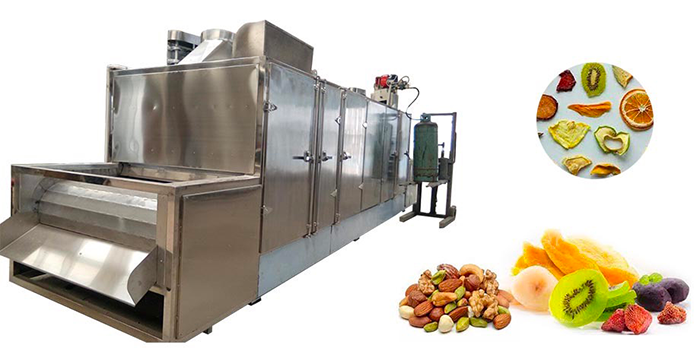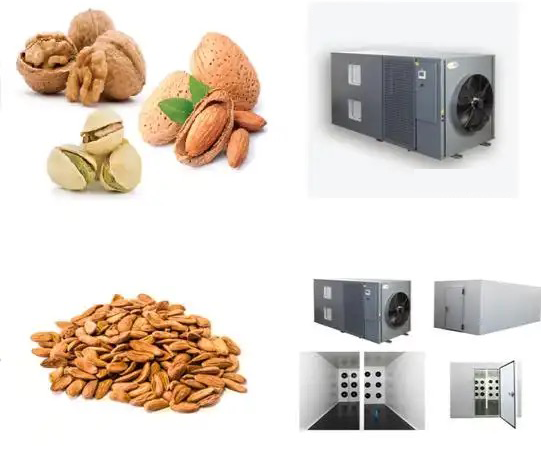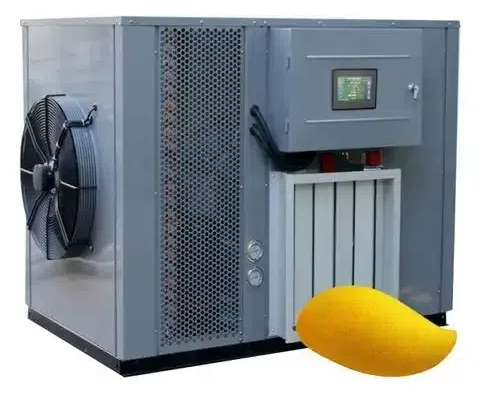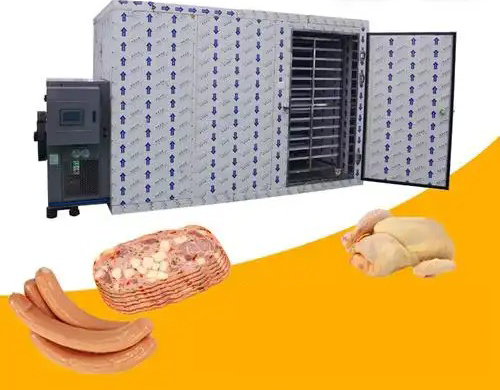
Content Menu
● Introduction
● What Is a Food Dryer?
● Types of Food Dryers
>> 1. Convection Dryers
>> 2. Freeze Dryers
>> 3. Microwave Dryers
>> 4. Vented Heat Pump Dryers
● Advantages of Vented Heat Pump Dryers
>> Energy Efficiency
>> Gentle Drying Process
>> Versatility
>> Reduced Environmental Impact
>> Cost-Effectiveness
● How Vented Heat Pump Dryers Work
● Factors to Consider When Choosing a Food Dryer
>> Capacity
>> Temperature Control
>> Maintenance Requirements
>> Space Requirements
>> Cost vs. Benefits
● Applications of Food Dryers in Different Industries
● Innovations in Food Drying Technology
● Conclusion
● Frequently Asked Questions
>> 1. What Is the Difference Between Vented Heat Pump Dryers and Traditional Dryers?
>> 2. Can I Use a Vented Heat Pump Dryer for All Types of Food?
>> 3. How Do I Maintain My Vented Heat Pump Dryer?
>> 4. What Are the Energy Savings Compared to Conventional Dryers?
>> 5. Are Vented Heat Pump Dryers Suitable for Commercial Use?
Introduction
In the food processing industry, drying is a critical method for preserving food products. With the increasing demand for dried foods globally, manufacturers are looking for efficient and effective drying solutions. This article explores the various types of food dryers available, focusing on vented heat pump dryers, their advantages, and considerations for OEM manufacturers.

What Is a Food Dryer?
A food dryer is a device that removes moisture from food to inhibit the growth of bacteria, yeast, and mold. Drying extends the shelf life of food products while retaining their nutritional value, flavor, and texture. Various drying methods exist, including air drying, sun drying, and mechanical drying.
Types of Food Dryers
1. Convection Dryers
Convection dryers use hot air to remove moisture from food. The hot air circulates around the food, allowing for even drying. These dryers are commonly used in commercial settings due to their efficiency. They can be designed with multiple trays or shelves to accommodate large batches of food simultaneously.
2. Freeze Dryers
Freeze dryers remove moisture by freezing the food and then applying a vacuum to allow sublimation. This method preserves the structure and nutrients of the food but is more expensive than other drying methods. Freeze-dried foods maintain their original shape and flavor, making them popular in the pharmaceutical industry as well as among outdoor enthusiasts who seek lightweight, nutritious meals.
3. Microwave Dryers
Microwave dryers use microwave radiation to heat and evaporate moisture quickly. They are suitable for drying small batches of food but may not be ideal for larger commercial operations. The speed of microwave drying can lead to uneven moisture distribution if not carefully managed.
4. Vented Heat Pump Dryers
Vented heat pump dryers combine the principles of heat pumps with ventilation systems to dry food efficiently while minimizing energy consumption. They are becoming increasingly popular in both domestic and industrial applications due to their energy-saving capabilities and gentle drying process.
Advantages of Vented Heat Pump Dryers
Energy Efficiency
Vented heat pump dryers are known for their energy efficiency compared to traditional dryers. They recycle heat generated during the drying process, reducing overall energy consumption significantly. This feature is particularly beneficial in regions where energy costs are high.
Gentle Drying Process
These dryers operate at lower temperatures compared to conventional methods, which helps preserve the quality of sensitive foods like fruits and vegetables. The gentle drying process prevents nutrient loss and maintains flavor, color, and texture better than high-temperature methods.
Versatility
Vented heat pump dryers can handle a variety of food products, from fruits and vegetables to meats and herbs. Their versatility makes them an ideal choice for OEM manufacturers looking to cater to diverse markets with different product lines.
Reduced Environmental Impact
By using less energy and producing less waste heat, vented heat pump dryers contribute to a lower carbon footprint compared to conventional drying methods. This aligns with global sustainability goals and appeals to environmentally conscious consumers.
Cost-Effectiveness
Though initial costs may be higher than traditional dryers, the long-term savings on energy bills make vented heat pump dryers a cost-effective option for manufacturers in the long run. Additionally, their durability often leads to lower maintenance costs over time.
How Vented Heat Pump Dryers Work
Vented heat pump dryers operate by using a refrigerant cycle to extract moisture from food products. The process involves several key steps:
1. Air Intake: Ambient air is drawn into the dryer through an intake system.
2. Heating: The air is heated using a compressor and evaporator that circulate refrigerant.
3. Drying: The heated air passes over the food items on trays or racks, evaporating moisture effectively.
4. Condensation: Moisture-laden air is vented out or condensed back into water through a cooling coil.
5. Recycling: The cooled air is reheated using residual heat from the system and recirculated within the unit.
This closed-loop system maximizes energy efficiency while ensuring effective moisture removal without compromising food quality.

Factors to Consider When Choosing a Food Dryer
When selecting a vented heat pump dryer for food processing, consider the following factors:
Capacity
Determine the volume of food you need to dry regularly. Choose a dryer with adequate capacity to meet your production needs without compromising efficiency or requiring multiple batches.
Temperature Control
Look for models with precise temperature control features that allow you to set specific drying conditions based on different types of food products being processed.
Maintenance Requirements
Consider the maintenance needs of the dryer. Regular cleaning of filters and checking seals for leaks will ensure longevity and consistent performance.
Space Requirements
Evaluate your facility's space constraints before purchasing a dryer. Vented heat pump dryers come in various sizes; choose one that fits your operational space without causing workflow interruptions.
Cost vs. Benefits
Analyze the initial investment against potential savings in energy costs over time. A higher upfront cost may be justified by long-term savings on energy bills and reduced maintenance needs.
Applications of Food Dryers in Different Industries
Food dryers have applications across various sectors:
- Agriculture: Farmers use dryers to preserve fruits and vegetables post-harvest, ensuring they reach consumers in optimal condition.
- Snack Production: Companies producing dried snacks rely on efficient drying methods that maintain flavor while extending shelf life.
- Herbal Products: The herbal industry benefits from gentle drying processes that preserve essential oils needed for high-quality herbal products.
- Meat Processing: Dried meats require specific temperature controls to ensure safety while maintaining desirable textures and flavors.
- Pet Food Production: Dried ingredients are often used in pet foods; thus, efficient drying methods are essential for maintaining nutritional value.
Innovations in Food Drying Technology
The field of food drying technology continues to evolve with innovations aimed at improving efficiency and product quality:
- Smart Technology Integration: Modern vented heat pump dryers can be equipped with IoT technology that allows real-time monitoring and control via mobile apps or computer systems.
- Advanced Sensors: Utilizing humidity sensors can help optimize drying cycles by adjusting temperature and airflow based on real-time moisture levels.
- Energy Recovery Systems: Some advanced models incorporate energy recovery systems that capture waste heat from the drying process for reuse within the system.
- Automated Cleaning Systems: Innovations include automated cleaning features that reduce downtime associated with maintenance tasks.
Conclusion
Vented heat pump dryers represent a significant advancement in food drying technology, offering energy efficiency, versatility, and cost-effectiveness tailored for OEM manufacturers in the food processing industry. By understanding various types of food dryers available and their respective advantages, manufacturers can make informed decisions that align with market demands and sustainability goals.
Investing in vented heat pump dryer technology not only enhances product offerings but also improves customer satisfaction by providing high-quality dried foods that meet consumer expectations for taste and nutrition.

Frequently Asked Questions
1. What Is the Difference Between Vented Heat Pump Dryers and Traditional Dryers?
Vented heat pump dryers are more energy-efficient than traditional dryers as they recycle heat during operation while maintaining lower temperatures that preserve food quality.
2. Can I Use a Vented Heat Pump Dryer for All Types of Food?
Yes, vented heat pump dryers are versatile enough to handle various food types, including fruits, vegetables, herbs, meats, nuts, and grains.
3. How Do I Maintain My Vented Heat Pump Dryer?
Regular maintenance includes cleaning filters regularly (at least once every few weeks), checking seals for leaks monthly, inspecting components such as fans or compressors periodically, and ensuring proper airflow around the unit to enhance efficiency.
4. What Are the Energy Savings Compared to Conventional Dryers?
Vented heat pump dryers can save up to 50% more energy than traditional electric or gas-powered dryers due to their efficient heating cycle that reuses warm air instead of expelling it entirely after each cycle.
5. Are Vented Heat Pump Dryers Suitable for Commercial Use?
Yes, many models are designed specifically for commercial applications; providing high capacity (often exceeding hundreds of kilograms per batch) along with durability required by businesses in diverse sectors within the food industry.












